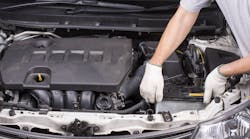The fact is, all batteries gradually lose their charge when stored over long periods of time. Therefore, to ensure the life and maximize battery capacity, batteries need to be properly stored.
How to do this is dependent upon a number of considerations, including: battery type, time of year, how the battery is stored and how long the battery will be in storage.
BATTERY TYPES
There are two main types of automotive batteries says Jennifer Eirich, marketing manager, Odyssey Battery, specialty and rail, EnerSys: flooded, or wet cell, and Valve Regulated Lead Acid (VRLA), also known as a maintenance-free.
EnerSys (www.odysseybattery.com) is a global leader in stored energy solutions for industrial applications and the manufacturer of Odyssey batteries.
“Flooded or wet cell batteries are traditional lead-acid batteries and are available in many size and design options for many different applications,” she says. “The most common design today is the maintenance-free, flat top, which the end user cannot service. A few older designs may have removable vent plugs to allow water replenishment.”
VRLA batteries come in two primary types: gel cell and absorbed glass mat (AGM).
- Gel cell batteries – These use a thickening agent to immobilize the electrolyte so that if the battery container cracks, the cell will continue to function, explains Eirich. Since gel cells are sealed and cannot be refilled with electrolyte, controlling the rate of charge is very important or the battery will be damaged.
- AGM batteries – The latest technology in lead-acid batteries, an AGM battery uses a fiberglass separator to hold the electrolyte in place and makes it spill-proof through a sealed pressure valve design, she says. This “makes AGM batteries superior to all other lead-acid battery types for vibration and impact resistance because of the plate compression design.”
AGM batteries are available in traditional lead-calcium grid or pure lead, which offers extended service life. Being sealed with pressure valves, these types of batteries are environmentally safe and can be classified as non-spillable for unrestricted shipping.
They can use similar voltage-set points as flooded cells and can be used as drop-in replacements for them. Pure lead AGM batteries can be charged with higher amperage alternators and chargers for faster charge recovery.
MAINTENANCE
Odyssey Battery’s Eirich says AGM batteries are maintenance-free and electrolyte levels do not need to be maintained. She notes that these types of batteries should not be opened once in service “as permanent damage and failure may occur.”
Flooded batteries, on the other hand, have an electrolyte level that must be maintained. This level must stay above the minimum and below the maximum level as indicated on the side of the battery, she says, “Check this level only when the battery is on a flat, level surface. If you need to increase the level, carefully add distilled water, avoiding any overfilling.”
There aren’t any primary differences regarding storage recommendations between flooded and AGM batteries if the vehicle is being stored with the battery still connected, says Gale Kimbrough, engineering and technical services manager, Interstate Batteries. An automatic maintenance charger should be attached to offset the vehicle’s key-off drains.
“Be sure to attach a charger designed for the battery type,” he says.
Interstate Batteries (www.interstatebatteries.com) touts itself as the No. 1 replacement brand battery in North America.
Kimbrough notes that if a vehicle is stored with the battery, but the cables are disconnected, the vehicle’s computer may need to go through a re-learn after reconnection.
“It’s always important to follow the vehicle manufacturer’s battery disconnection guidelines,” he says.
STORAGE RECOMMENDATIONS
Some guidelines to adhere to when storing a battery.
1. Look for damage.
Inspect the battery for damage, such as cracks and corrosion, says Kimbrough of Interstate Batteries. On flooded batteries, check for low electrolyte levels.
2. Clean the battery.
Batteries should be cleaned prior to storage to remove any electrolyte deposits or corrosion, Kimbrough says. If electrolyte deposits and/or dirt/dust are present, batteries will often self-discharge quickly due to transient power loss between the negative and positive terminals.
He suggests cleaning the battery terminals with a baking soda/water mix or battery spray cleaner.
Brad Bisaillon, director of strategic accounts, North America and Europe, Trojan Battery Company, adds: “It is imperative to properly maintain the entire connection in a flooded battery because corrosion at either end of the connection can cause high resistance and potential battery failure.”
Trojan Battery Company (www.trojanbattery.com) is a world-leading manufacturer of deep-cycle batteries.
He recommends cleaning battery terminals and cable lugs regularly “with a solution of one cup of baking soda and one gallon of water using a wire brush. Rinse with water and dry. Then, thinly coat all connections with anti-corrosion spray or silicone gel to resist corrosion.”
Along with cleaning corrosion and electrolyte deposits, Odyssey Battery’s Eirich suggests cleaning the case according to battery manufacturer’s instructions.
3. Select an appropriate storage location.
All deep-cycle batteries will self-discharge when not in use for an extended period of time, and this may cause irreversible damage, says Trojan Battery’s Bisaillon.
“The amount of self-discharge depends on the temperature of the storage location and the duration of time the batteries are in storage,” he says.
A deep-cycle battery has the ability to be deeply discharged and charged many times during its service life.
Interstate Batteries’ Kimbrough recommends storing batteries “fully charged in a dry location with adequate ventilation between 40 and 60 degrees F. The warmer the temperature, the faster the battery will self-discharge.”
Flooded lead-acid batteries discharge faster – about 3 to 5 percent a month, compared to AGM battery’s 1 to 3 percent, he says.
Because higher humidity areas can increase the battery’s corrosion, he advises choosing a dry location.
If freezing temperatures are expected during the storage period, Bisaillon says these locations should be avoided.
“The electrolyte in an acid-filled battery may freeze if the battery becomes deeply discharged and is stored in an unheated environment in cold weather,” notes Eirich of Odyssey Battery.
Kimbrough adds: “A fully charged lead-acid battery, whether it’s flooded or AGM, will not freeze until the temperature falls to -80 degrees F. However, a completely discharged battery can freeze solid at 32 degrees F.”
The battery manufacturer’s guidelines should be consulted to find the lowest acceptable storing temperature, Eirich says.
Kimbrough adds that batteries should always be stored fully charged to protect from deterioration and from freezing solid. A discharged battery can undergo sulfation – a process where the battery’s internal components deteriorate because of the lack of charge.
Proper charging is the only way to break up internal sulfation and prevent its buildup on the plates within a battery, adds Eirich. The buildup can lead to permanent damage and premature battery failure.
All three mentioned that batteries should be stored in places with adequate ventilation and away from flammable liquids as they expel hydrogen and oxygen during recharge. Batteries should also be stored away from areas near heat sources, such as radiators or heaters, since hot temperatures accelerate battery self-discharge
4. Monitor and test.
Trojan Battery’s Bisaillon notes that monitoring the overall health of deep-cycle batteries “is vital because while physical inspection is important, it is not sufficient to determine the condition of a battery. Instead, measuring and understanding the state of charge (SOC) of a battery is key to maintaining performance and extending overall lifecycle.”
He says conducting routine open-circuit voltage and specific gravity readings can be a good indicator on a battery’s overall SOC and health. But before carrying out battery testing, it is necessary to remove any loads and ensure the battery has been fully charged.
A digital voltmeter can be used to measure the battery’s open circuit voltage (OCV), says Odyssey Battery’s Eirich. However, “do not measure the OCV until at least eight hours after the battery has been charged to ensure that chemical reactions inside the battery have reached a state of equilibrium. The battery manufacturer’s specifications will indicate what OCV values will correspond to various states of charge.”
“Batteries need to be monitored weekly, especially if you’ve left a charger connected to them,” says Kimbrough of Interstate Batteries. “A standard voltmeter can test both an AGM and a flooded battery.
“If the battery’s voltage falls below 12.45V, recharge the battery. If the voltage is that low, it means the battery only has 30 to 40 percent charge left.”
Bisaillon suggests that battery voltage be monitored every six weeks while in storage and that the batteries be given a boost charge when they are at 70 percent SOC charge or less.
OUT OF STORAGE
Before taking a battery out of storage, check to make sure the batteries are fully charged, says Odyssey Battery’s Eirich. Re-check for any corrosion or damage. If corrosion is present, it should be cleaned off.
Interstate Batteries’ Kimbrough adds that for flooded batteries, the electrolyte levels should be 1/2” above the plates.
“If they’re low, refill the battery with distilled water and recharge it,” he says.
If or when installing the battery in the vehicle, he recommends cleaning all battery attaching terminals and then connecting the positive cable first and the negative cable second.
David A. Kolman is editor of Fleet Maintenance, the only publication that provides a wide-ranging curriculum and best practices to enable readers to keep vehicles operating with greatest efficiency and maximum uptime, and improve their personal performance. An award-winning journalist, he has been actively involved in the North American transportation industry for more than 30 years.



